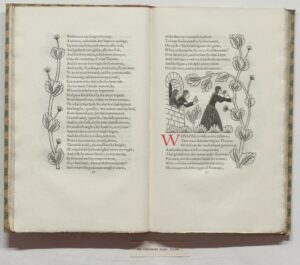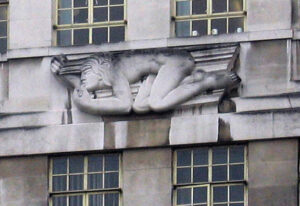Geoffrey Chaucer, ‘The Canterbury Tales’, with wood engravings by Eric Gill
16 June 2020
By Dr Cynthia Johnston, Institute of English Studies, School of Advanced Study, University of London

Geoffrey Chaucer, The Canterbury Tales, wood engravings by Eric Gill, vol 1. (Walthan St Lawrence: The Golden Cockerel Press, 1929). On loan from the Harris Museum, Art Gallery and Library.
This edition of Chaucer’s Canterbury Tales is one of the most famous productions of the Golden Cockerel Press, founded by Harold (Hal) Taylor in 1920. By the time of the Canterbury Tales, the press had been bought by the wood engraver, Robert Gibbings, in 1924. Under Gibbings stewardship, the press continued true to the aims of the original founders in the spirit of a cooperative venture with a democratic blend of contributions from both artists and artisans. Gibbings and his wife Moira worked closely with the printing staff, and produced books which reflected the artisan aspirations of the private press movement. Before the press was sold in 1933, and when it in fact became a publishing house as opposed to a private press, the Golden Cockerel produced 71 books. The Canterbury Tales is one of the most successful of these. This is one of only 485 copies printed on Batchelor hand-made paper with wood engravings by Eric Gill.

North Wind, Eric Gill, 55 Broadway, St James’s. Photograph © Andrew Dunn, 29 September 2004 (CC BY-SA 2.0).
The controversial sculptor and typeface designer, Eric Gill, was closely associated with the Golden Cockerel Press, and designed its typeface in 1931. In addition to his engravings for The Canterbury Tales, Gill provided the engravings for another of the Golden Cockerel’s great successes, The Four Gospels, published in also in 1931. Some of Gill’s engravings were considered erotic enough to be pushing the boundaries of acceptability, and a portion of his illustrations provided for these Christian texts did sail quite close to the wind.

Ariel between Wisdom and Gaiety, Eric Gill, Broadcasting House, London. Photo © Mike Knell (CC BY-SA 2.0)
While Gill was the most celebrated graphic designer of his time, and the importance his contributions to 20th century design are undisputed, the publication of Fiona McCarthy’s biography of Gill in 1989 rocked his reputation. Revelations of Gill’s sexual practices, which involved both bestiality and incest, provoked the question as to whether his art could still be admired in the context of his sexual mores. Gill’s sculptures adorn many public monuments including what is now the office of Transport for London on 55 Broadway Saint James, and Broadcasting House, in London, as well as the art deco masterpiece, the Midland Hotel in Morecambe. His most popular typeface is Perpetua, but he designed many others including Gill Sans, Solus and Joanna. Gill’s work is part of the fabric of our lives in twenty-first century Britain. However, he remains an uncomfortable presence in modern design whose life choices force us to examine whether his actions should influence our response to his art.